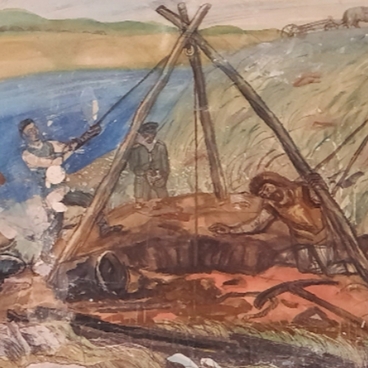The outstanding graphic artist KamIl Gubaydullin was born in Ishimbay in 1949. In his genre painting titled ‘An Old Oil Field, ’ the artist depicted a scene from the history of his homeland: the work at Ishimbay oil fields in the 1930s.
The picture is unusual for its subject, featuring a camel with a wooden cart against the background of, as yet, primitive wooden drilling rigs that have, nonetheless, already obscured almost the entirety of the horizon, like the pipes of a huge factory. Gubaydullin highlighted the contrast between the traditional Bashkir lifestyle and the intense construction of the new capital of the Soviet oil industry. with his use of opalescent shades of gouache. They range from calm, pale blues and whites of the sky to harsh maroon and brown colors used for the ground and oil facilities.
GubaydUllin wasn’t there to see these places in the 1930s; however, like all local residents, he was well aware of the then-recent glorious history of IshimbAy. First commercial oil was obtained here on May 16, 1932. That day brought real stardom to the entire IshimbAy region: it was then that the whole Soviet Union learned about the small village of IshimbAevo. After the discovery of oil in the area, the village began to rapidly develop as a worker’s settlement for drillers and refiners; as many as about 10 thousand people came here in just a couple of years. Some time during the village’s early years, 101 KazakhstAni families came to Ishimbaevo on their camels, which were subsequently used to transport not just people, but also building materials, oil equipment, and other cargo.
Ishimbaevo’s housing opportunities for newly arrived workers could not keep up with the settlement’s unparalleled growth. In early 1935, only 18.3 percent of the settlement’s population had permanent housing, while 14.4 percent lived in barracks, 37 percent in dugouts, and about 20 percent in nearby villages. Many workers also came to the oil fields from the major Bashkir city of Sterlitamak, which neighbored Ishimbaevo. Some workers found shelter in tents, which accommodated 50 people each, before they were rehoused to barracks and dugouts with the coming of November frosts. Each barracks room housed three, sometimes five families with children. Overcrowding and poor sanitation led to outbreaks of various diseases; cases of typhoid fever were a common occurrence among workers.
Despite all these difficulties, the Ishimbay field’s daily oil production rose from 4,500 metric tons in 1932 to 962,000 in 1937. Thus, Bashkortostan’s share in the Soviet oil production increased from 0.1 percent to 3.5 percent. In February, the worker’s settlement of Ishimbaevo was finally recognized as a city. At that time, it had a population of 23,000 people, as well as a polyclinic, a hospital with a capacity of 80 beds, 10 schools, and three kindergartens. Additionally, at the disposal of local residents were a community center, a cultural complex, 18 stores, and a cafeteria.
The picture is unusual for its subject, featuring a camel with a wooden cart against the background of, as yet, primitive wooden drilling rigs that have, nonetheless, already obscured almost the entirety of the horizon, like the pipes of a huge factory. Gubaydullin highlighted the contrast between the traditional Bashkir lifestyle and the intense construction of the new capital of the Soviet oil industry. with his use of opalescent shades of gouache. They range from calm, pale blues and whites of the sky to harsh maroon and brown colors used for the ground and oil facilities.
GubaydUllin wasn’t there to see these places in the 1930s; however, like all local residents, he was well aware of the then-recent glorious history of IshimbAy. First commercial oil was obtained here on May 16, 1932. That day brought real stardom to the entire IshimbAy region: it was then that the whole Soviet Union learned about the small village of IshimbAevo. After the discovery of oil in the area, the village began to rapidly develop as a worker’s settlement for drillers and refiners; as many as about 10 thousand people came here in just a couple of years. Some time during the village’s early years, 101 KazakhstAni families came to Ishimbaevo on their camels, which were subsequently used to transport not just people, but also building materials, oil equipment, and other cargo.
Ishimbaevo’s housing opportunities for newly arrived workers could not keep up with the settlement’s unparalleled growth. In early 1935, only 18.3 percent of the settlement’s population had permanent housing, while 14.4 percent lived in barracks, 37 percent in dugouts, and about 20 percent in nearby villages. Many workers also came to the oil fields from the major Bashkir city of Sterlitamak, which neighbored Ishimbaevo. Some workers found shelter in tents, which accommodated 50 people each, before they were rehoused to barracks and dugouts with the coming of November frosts. Each barracks room housed three, sometimes five families with children. Overcrowding and poor sanitation led to outbreaks of various diseases; cases of typhoid fever were a common occurrence among workers.
Despite all these difficulties, the Ishimbay field’s daily oil production rose from 4,500 metric tons in 1932 to 962,000 in 1937. Thus, Bashkortostan’s share in the Soviet oil production increased from 0.1 percent to 3.5 percent. In February, the worker’s settlement of Ishimbaevo was finally recognized as a city. At that time, it had a population of 23,000 people, as well as a polyclinic, a hospital with a capacity of 80 beds, 10 schools, and three kindergartens. Additionally, at the disposal of local residents were a community center, a cultural complex, 18 stores, and a cafeteria.



